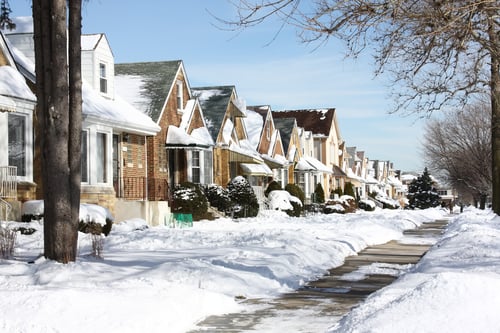Designing Heating Systems for the Coldest Winters

In places with cold winters, space heating systems have a fundamental role in buildings. Without them, indoor temperatures would quickly become unsuitable for human occupancy. The local weather is one of the most important factors when designing a heating system; if two identical buildings are developed in Miami FL and New York City, the heating load will be much higher for the NYC property.
Building heating systems are characterized by a wide range of available configurations. The following are some ways in which heating system can be classified:
-
By energy source: Some common options are natural gas, heating oil, propane, and electricity. Steam or biomass may also be available.
-
By heat distribution method: Some heating systems release heat directly into the air, while others use water or steam as a heat transfer medium between heating equipment and indoor areas. There are also radiant heating systems, with hot water pipes or resistance panels embedded in walls and ceilings.
-
By layout: Some designs use centralized heating equipment for the entire building, while others use a separate installation for each building area.
Like in all engineering decisions, there is no “best” option when dealing with space heating. Since every building is unique, the optimal space heating configuration changes depending on the property. The local climate must also be considered, since it influences performance.
Design an adequate building heating system for your climate zone.
Heating System Performance During Extreme Winters
Space heating systems are taken to their limit during the coldest days of winter, especially when large masses of cold air move from the poles to temperate regions. For example, New York has reached winter temperatures below -10°F, while Chicago has seen winters under -20°F.
Fuel combustion and electric resistance have been used for decades as heating methods:
-
Combustion-based heating systems have a lower operating cost, but they produce greenhouse gas emissions. Note that even biomass heaters release emissions.
-
Electric resistance heaters are emissions-free, but their operating cost is very high, especially if you live in a place with cold winters.
Electric heat pumps are a more modern option: they offer clean operation just like resistance heaters, while having operating costs comparable to those of combustion heaters. A heat pump can be visualized as a refrigerator or air conditioner operating in reverse:
-
Just like an air conditioner removes indoor heat with the evaporation and compression of refrigerant, a heat pump can extract thermal energy from outdoor air.
-
Air-source heat pumps extract heat from outdoor air.
-
Ground-source heat pumps extract heat from the underground.
Air-source heat pumps have a key limitation in the extreme cold: their efficiency drops along with temperature, and they are as inefficient as a resistance heater when outdoor temperature drops below the freezing point of water (32°F). At this point, the heat pump may simply be unable to produce enough heat for its respective indoor area. Another challenge is preventing the accumulation on frost on the outdoor components of heat pumps - some models are equipped with a defrosting system that removes ice at regular intervals.

Ground-source heat pumps can operate efficiently during cold weather, but they come with a higher price tag. The main challenge when installing these heat pumps is burying the water loop that collects underground heat. The installation can be especially difficult if the building is in a crowded urban center with no direct access to the ground.
Combustion-based heaters and resistance heaters do not suffer a loss of performance during cold weather, as long as their energy input is available. However, note that combustion heaters may suffer from a fuel shortage in some cases:
-
If the heating system relies on a fuel that is delivered by truck, the supply can be interrupted during extreme weather.
-
Natural gas heaters are served by an underground piping system, making them the most reliable option.
Enhancing a Heat Pump with a Backup Heating System
When air-source heat pumps are used in places with very cold winters, a common solution is adding combustion heating or resistance heating as backup. This configuration is called a hybrid heating system.
-
When outdoor temperatures are within the optimal range for the heat pump, the building owner can take advantage of its superior efficiency.
-
If temperature is too low for the heat pump alone, the backup heating system activates.
A heat pump with a backup gas heater achieves the lowest operating cost, but is also the most expensive option because two energy sources must be installed. On the other hand, a heat pump with backup resistance heating is more affordable because there is only one energy source - the downside is getting a very high electricity bill during the coldest winter months.
To get an optimal heating system configuration for your building, the best recommendation is getting in touch with a qualified MEP engineering firm. Professional engineers are highly familiarized with local building codes, and they can design a high-performance installation while getting a quick project approval from local authorities.

Michael Tobias
Michael Tobias, the Founding Principal of NY Engineers, currently leads a team of 150+ MEP/FP engineers and has led over 4,000 projects in the US
Join 15,000+ Fellow Architects and Contractors
Get expert engineering tips straight to your inbox. Subscribe to the NY Engineers Blog below.

